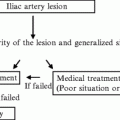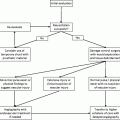Closure device
Sheath sizes
Time till hemostasis
Permanent implant
Immediate repuncture
Angio-Seal
6,8
Short
No
No
Perclose
Perclose 5–8
Prostar XL 8–10
Short
Yes
Yesa
Starclose
5,6
Short
Yes
Yesa
Catalyst
5,6,7
Intermediate
No
Yes
Mynx
5,6,7
Intermediate
No
No
Exoseal
5,6,7
Short
No
No
Invasive, active approximation, intraluminal, thrombosing, temporary/resorbable.
Angio-Seal comprises two hemostatic mechanisms: active approximation and thrombosis. Initially, the arteriotomy site is approximated between an intra-arterial T-shaped resorbable anchor and an extravascular collagen plug, held together by a suture. The second hemostatic mechanism is the thrombosing effect of collagen. This device is considered highly effective, with one of the highest primary success rates among VCDs. All three components are absorbed within 90 days.
The Instructions for use (IFU), states that it can be immediately repunctured. In addition, for diagnostic cases it is labeled for 20-min ambuation and 60-min discharge for diagnostic cases
B.
Perclose (Abbott Vascular, Santa Clara, CA) (Table 36.1)
Invasive, active approximation, intraluminal, nonthrombosing, permanent/nonresorbable.
The first suture-mediated VCD to be approved by the FDA was the Perclose device, which allows the insertion of a nonresorbable suture (monofilament polypropylene) directly into the arterial wall adjacent to the arteriotomy, which straddles the surrounding intima. Although not approved by the FDA, for this specific indication, this device is amenable to immediate repuncture.
C.
Starclose (Abbott Vascular, Santa Clara, CA) (Table 36.1)
Invasive, active approximation, extraluminal, nonthrombosing, permanent/nonresorbable.
This device consists of a nitinol clip designed to be deployed outside the arterial lumen, in the media. The Starclose nitinol clip is nonresorbable, has no thrombosing effect, and has a theoretical decreased risk of infection attributed to the absence of a thrombosing plug. This device is also amenable to immediate repuncture, although the FDA has not yet approved this indication.
D.
Catalyst (Cardiva Medical, Mountain View, CA) (Table 36.1)
Invasive, passive approximation, nonthrombosing/sealing, no foreign body.
The Catalyst closure device has the advantage of being delivered through the procedural sheath. Compression of the arteriotomy site occurs from inside the artery with a nitinol disk that is removed afterward through the fresh clot, leaving no “footprint” inside the artery. This temporary hemostasis allows the arteriortomy site to recoil to the size of an 18-gauge needle. The spring mechanism of the nitinol disk maintains traction at the puncture site from inside the vessel, but after removal, compression is required to achieve complete hemostasis, but for a shorter period of time than would be required for the original arteriotomy. In addition, the Catalyst has topical agents that help promote hemostasis when exposed to the tissue track during removal.
Catalyst III is indicated for use in patients receiving heparin as it is coated with protamine sulfate.
This VCD is amenable to repuncture.
E.
Mynx (Access Closure, Mountain View, CA) (Table 36.1)
Invasive, passive approximation, sealing, temporary/resorbable.
Passive approximation of the arteriotomy site is achieved with a sealing (nonthrombosing) agent outside the artery, polyethylene glycol, that is delivered through the procedural sheath used; this last characteristic makes this VCD one of the best tolerated by patients. This is also beneficial when considering a decreased infection risk and avoidance of upsizing the track by using the existing sheath. The sealant dissolves within 30 days.
F.
Exoseal (Cordis Corporation, Miami Lakes, FL) (Table 36.1)
Invasive, active approximation, intramural, thrombosing, temporary/resorbable.
The arteriotomy site is sealed by the deposition of an absorbable plug (polyglycolic acid) on the extravascular surface. The device is deployed through the procedural sheath. The plug is completely absorbed in 60–90 days.
Stay updated, free articles. Join our Telegram channel

Full access? Get Clinical Tree







